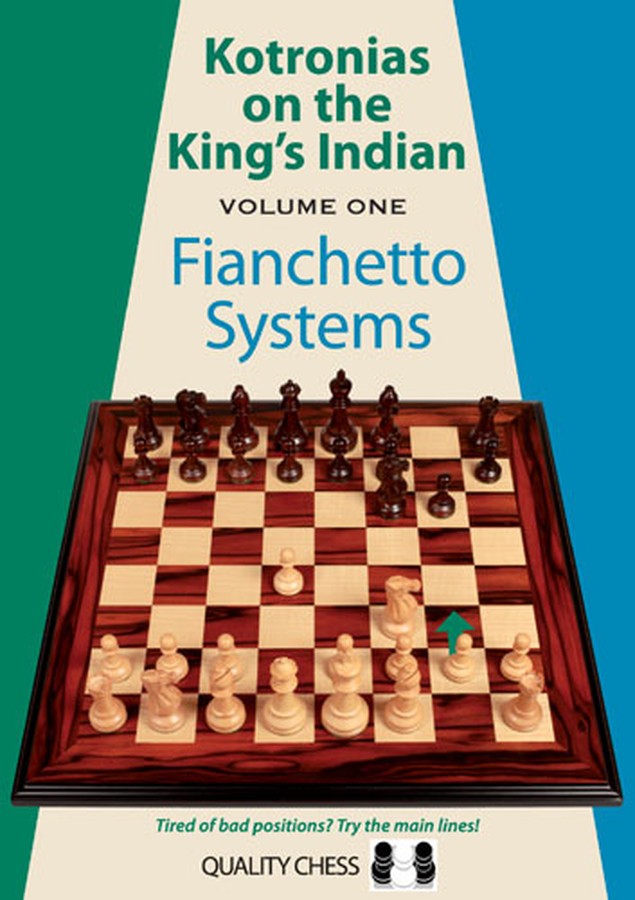| Nivå | C-D |
| Utgivelsesdato | Juli 2013 |
| Forfatter | |
| Pris | 500 NOK |
Kotronias on the King's Indian 1 Fianchetto Systems
Kongeindisk er selvfølgelig ett av svarts viktigste og spenstigste valg mot 1 d4. Mye er skrevet om denne åpningen, men her kommer etter alt å dømme den hittil grundigste presentasjonen i bokform, som et repertoar for svart. Dette første bindet er 720 sider om varianter der hvit spiller g3.
Den greske stormesteren Kotronias skriver heldigvis klart, ryddig, nøyaktig og litt underholdende. Likevel er nok dette ambisiøse konseptet mest for spillere med ratingstyrke fra omlag 1500, og helt opp, eller for spillere som i alle fall har lært seg endel kongeindisk fra før, gjennom for eksempel en av Joe Gallaghers utmerkede og mer overkommelige bøker...
Preface
What you are holding in your hands is the first volume of an ambitious and elaborate work on the King’s Indian. It is ambitious because it aims at nothing more and nothing less than exposing myths and truths about this popular opening, while offering a sound black repertoire based on dynamic and imaginative play. It had to be elaborate, because our times demand accuracy and concrete analysis rather than abstract ideas. The only miracle I know is hard work; the only doubting Thomas I know is the one who has not witnessed it.
This first volume is dedicated to systems involving an early g2-g3 from White. I deemed it right to deal first with the most annoying of strategies, that challenges head-on our wish to complicate the game. White’s popular set-up, used in the past by no lesser players than Botvinnik, Korchnoi and Karpov, involves an early kingside fianchetto and thus significantly reduces our attacking chances against the enemy king.
However, there is good news from Black’s point of view as well. In adopting such a strategy White renounces his own chances of an early queenside onslaught. Play takes on a delicate semi- positional nature as the centre remains in most cases fluid, with guerrilla tactics and trench warfare becoming the rule rather than the exception in this type of battlefield. Thus, my feeling is that the position does not lack dynamic elements and King’s Indian players will often have the possibility for a tactical skirmish, provided they are a bit more patient than usual.
I have chosen to base our repertoire on systems where Black places his queen’s knight on d7, a method of development favoured by such legendary players as Bronstein, Najdorf and Geller, and subsequently honed into a formidable weapon by the 13th World Champion Garry Kasparov. Don’t ask me whether or not this system is objectively better than developing the knight on c6; everyone has his own personal style and chess philosophy. Please also bear in mind that in chess, just as it so often happens in life, our choices are influenced by relative factors. We regularly have to settle for a satisfactory solution rather than search for a perfect one. Ideally I would have liked to have presented both major systems here, but that would have pushed the already stratospheric page count to one of astronomical proportions.
I would like to draw your attention to a key issue of primary importance. The supporting analysis presented in this book should not and indeed cannot be memorized in its entirety by anyone in the world. It is intended to widen your thinking horizon, to expand your positional and tactical arsenal, and to show that there are always solutions, even in the most difficult situations. By going through the analysis you will enhance your instincts and bolster your confidence, in both the correctness of Black’s set-up and your own ability to find the right solutions at critical moments. Having said that, of course there are certain lines that do have to be memorized more thoroughly, but they are pointed out by yours truly and are not too numerous.
To conclude this short introduction I would like to thank several people, but right now only three names spring to mind:
Jacob Aagaard, for putting on the table the idea for a lifetime repertoire on the King’s Indian Defence.
Ioannis Simeonidis, my close friend and chess associate, for rechecking a few important lines in non c2-c4 systems.
And last, but not least... Andrew Greet, for bringing to my attention sources and ideas that I was not aware of, and doing a wonderful editing job of which very few in the chess world are capable.
Vassilios Edmilson Kotronias Athens, 27 May 2013
| Innbundet? | Nei |
| Type | Bok |
| Språk | Engelsk |
| Antall sider | 720 |
Produktet er en del av serien Kotronias on the King's Indian
Den kjente greske stormesteren Kotronias serverer den hittil grundigste gjennomgangen som er gitt av åpningen Kongeindisk, og i form av et nøyaktig utarbeidet repertoar for svartspilleren, mot de svært mange mulighetene som finnes å ta hensyn til ...
Se også
-

Play the King's Indian A Complete Repertoire for Black in this most Dynamic of Openings
KjøpDette er boka som i dag gir deg best oppdaterte og systematiske kunnskaper i kongeindisk.
- Pris
- 215
- Nivå
- C-D
- Av
- Utgivelsesdato
- November 2004

